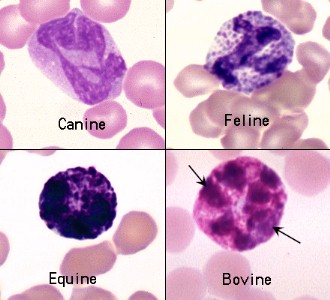Prototypical basophils of human blood are filled with small, round, dark purple
granules. Similar basophils are found in some species but not in others.
 Canine basophils are difficult to recognize since many do not have readily apparent
granules. The major identifying features of canine basophils are the long and folded
nucleus, described as ribbon-like, and the unusual gray to lavender hue of the cytoplasm.
Some basophils contain a few purple granules. Basophils are rare in blood of healthy dogs.
Canine basophils are difficult to recognize since many do not have readily apparent
granules. The major identifying features of canine basophils are the long and folded
nucleus, described as ribbon-like, and the unusual gray to lavender hue of the cytoplasm.
Some basophils contain a few purple granules. Basophils are rare in blood of healthy dogs.
Feline basophils are packed with small, slightly oval granules that are pale lavender rather than deep purple. The nucleus in many appears to have vacuoles, which are actually granules lying on top of the chromatin. Basophils are rare in blood of healthy cats. Basophils of horses and ruminants are similar to each other and to human basophils. These cells contain many small deep purple granules that obscure the nucleus in many cells. Arrows point to nuclear lobes in the picture of a cow basophil. Some basophils have few granules, which probably is the result of degranulation in the sample. Low numbers of basophils are commonly found in blood of healthy cattle and horses. |
Last updated on Saturday, February 24, 1996